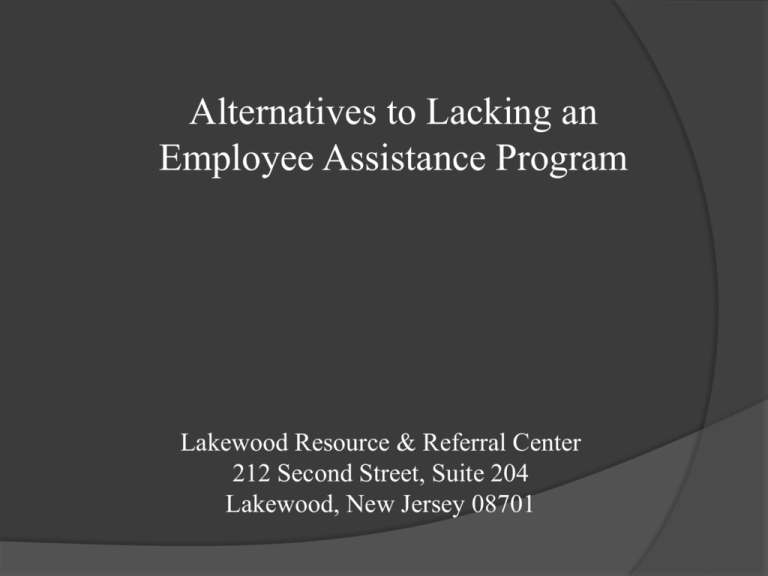PowerPoint file
advertisement

Alternatives to Lacking an Employee Assistance Program Lakewood Resource & Referral Center 212 Second Street, Suite 204 Lakewood, New Jersey 08701 • Qualities of Difficult People • Common Responses to Difficult People • 10 Common Difficult Personalities (and how to deal with them) • How to Defuse an Angry Person • Listening Skills with Difficult People • Your Difficult Person Qualities of difficult people •Overreact to criticism •Appear very anxious •Avoid others or hide information •Manipulate others •Blame Others •Show wide or sudden shifts of mood for no obvious reason •Exhibit loss of emotional control •Become hostile for no apparent reason •Attack others physically or verbally •Seem apathetic •Are overly controlling •Seem rebellious •Become argumentative Common Responses to Difficult People •Anger •Frustration •Complaining •Walking on eggshells •Being overly nice •Arguing •Enduring abuse silently 10 Difficult Personalities Leading to Conflict in the Workplace (and How to Deal with Them) •The Hostile/Aggressive •The Toady •The Pessimist •The Skeptic •The Complainer •Shy and Quiet •The Know-it-All Expert •The Overcontroller •The Narcissist •The Indecisive Staller The Hostile/Aggressive THE SHERMAN TANK, THE EXPLODER, MEAN AND ANGRY How to Deal with this Personality: 1. Stand up to them without aggression. If you allow a fight to escalate you will never win and you may end up losing both the battle and the war. 2. Be assertive and express your opinion respectfully (“In my opinion…and so I disagree with you”). 3. Take a deep breath and calm yourself. 4. Move the discussion to a neutral site. The Hostile/Aggressive 4. If attacked, do not counter-attack. Such personalities feed on the anger of others – it empowers them. 5. Instead ask them firmly to sit down and explain calmly what they have to say. Listen calmly in return. 6. Give them time to wind down and run out of steam…avoid a direct confrontation. 7. Take unpredictable actions to distract their attention: drop a book, stand up; firmly call them by name. 8. Don’t be surprised by friendly overtures as soon as they view you as worthy of respect. The Pessimist THE NEGATIVIST How to Deal with this Personality: 1. Recognize your own vulnerability to being sucked into feeling discouraged. Negativity can be contagious unless met directly with confident, assertive optimism. 2. Don’t argue with them or embarrass them. You won’t get far by making this a win/lose battle. 3. Allow them to play the role of “reality checker” by analyzing what could indeed go wrong. Validate the usefulness of their defensive pessimism. The Pessimist 4. Require them to cite specifics rather than make sweeping generalizations. 5. Offer examples of past successes. Highlight the value of exploring other alternatives. 6. When alternatives are discussed, bring up the negatives yourself. 7. Don’t try to talk them out of their pessimistic life perspective. 8. Discuss the problem thoroughly without offering solutions. 9. Be ready to take action alone without their agreement. The Complainer How to Deal with this Personality: 1. Break the self-fulfilling cycle of passivity, blaming and powerlessness by using a problem solving approach. 2. Ask for complaint in writing. 3. Assign them fact-finding tasks. 4. Listen attentively. They may just need to blow off steam 5. Be prepared to interrupt and take control. 6. Pin them down to specifics. Despite complaining they may be able to provide you with useful information. The Complainer 7. Be careful when agreeing. You do not want to validate that everything is your fault and that they are blameless. 8. If all else fails, ask them how they would like the discussion to end; what results do they want to achieve? 9. Acknowledge their feelings but avoid complaining along with them; don’t get sucked into their dysfunctional pattern. 10. State the facts clearly without apology…remain in problemsolving mode. The Know-it-All Expert THE BULLDOZER How to Deal with this personality: 1. Help them consider alternative views while avoiding direct challenges to their expertise. 2. Do your homework, prepare well, discuss facts in an orderly manner, and make sure that your information is accurate and complete. 3. Don’t ‘ball park’ it or they will dismiss you as incompetent. 4. Don’t be intimidated, or let them take over the meeting. The Know-it-All Expert 5. Do listen to them and try to benefit from their knowledge. 5. Listen actively and acknowledge. Paraphrase rather than interrupt; it shows that you respect their expertise. 6. If you must point out an error or omission, do it by questioning firmly with confidence and asking for clarification (e.g., “how might that look 5 years from now?”) 7. Resist the temptation to assert your own expert credential. It won’t work. No one knows more than they do in their opinion. The Narcissist BALLOONS - ALWAYS RIGHT How to Deal with this Personality: 1. Know how you feel about the person and how they affect you. 2. Identify and recognize their talents – especially underutilized ones – and lead them to activities that test these talents. 3. Avoid the temptation to burst their bubble – they are really rather fragile underneath the confident exterior. 4. Encourage their participation in activities that require their dependence on others. 5. Give them opportunities to teach and work with others. The Narcissist 6. Have them role-play a timid or shy person to feel the other sides. Use similar techniques to encourage empathy. 7. State correct facts or alternative opinions as descriptively as possible; avoid deflating their opinions. 8. Provide them with a means to save face; don’t humiliate them. 9. Be ready to fill the conversation gap yourself. 10. Coping with them when they are alone (one-on-one) is easier. The Toady THE SUPER AGREEABLE ETERNAL OPTIMIST How to Deal with this Personality: 1. Treat them well and in a positive manner. 2. Give them only the information you want them to know. 3. Understand and appreciate their power and value. 4. Insist that they support their positions with facts and figures – and do the same in turn. 5. Ask them to disclose their dislikes. 6. Invite them to disagree with you – make it safe for them to do so. The Toady 7. Become a confidant, when possible. Be someone they feel they can trust. 8. Be ready to negotiate and compromise if open conflict is likely. 9. Ask them to tell you about things that might interfere with your good relationship. 10. Listen closely to their humor as there may be hidden messages contained in it. The Skeptic THE BACKSTABBER, THE NAY SAYER How to Deal with Them: 1. Disentangle yourself from their web of suspicion. 2. Never pass suspicion down. 3. Watch yourself and monitor your reactions carefully. 4. Open dialogue with others to relieve suspicion. 5. Don’t believe anything they say about you in person or behind your back. The Skeptic 6. Document everything. 7. Be open, honest, and professional – and therefore guiltless. 8. Don’t allow yourself to be intimidated or targeted. 9. And remember that the truth, like sunshine, always comes out! The Shy and Quiet THE CLAMS How to Deal with this Personality: 1. Put yourself in their shoes. Do not mistake shyness for aloofness. 2. Use one-to-one and small-group environments to draw them out of their shells. 3. Encourage them to join work-committees and organizations. 4. Develop trust and friendship with this person whenever possible. 5. Help them prepare for tough situations. 6. Ask open-ended questions. The Shy and Quiet 7. Wait as calmly as possible for a response. 8. Don’t rush to fill in silence with your conversation. 9. Plan enough time to allow you to wait with composure. 10. When they open up, be attentive and watch your own impulse to gush. 11. Flow with tangents, they may lead to something enlightening. 12. Leave them with food for thought and establish another meeting. The Overcontroller THE WATCHDOG, THE DRAGON How to Deal with this Personality: 1. Free yourself mentally from being suffocated. 2. Know what is happening to you and develop skills to deal with it. 3. Provide a lot of feedback. 4. Know your own strengths and limitations. 5. Be properly and respectfully assertive in all interactions. The Overcontroller 6. Be as proactive as possible (out-think them). 7. Write things down in front of them. 8. Don’t argue without supporting evidence. 9. Don’t let them entice you into unprofessional behavior. 10. Avoid the temptation to micro-manage them when you get the chance – such passive-aggressive retaliation serves no healthy purpose. The Indecisive Staller How to Deal with this Personality: 1. Make it easy for them to tell you about conflicts or reservations. 2. Listen for indirect words, hesitations, or omissions that might provide clues. 3. Help them make a decision by examining the facts. 4. Find out if the problem is you and reassure them it is not. 5. Emphasize the importance of quality work. The Indecisive Staller 6. Give support after they make a decision. 7. If possible, keep the action steps in your hands. 8. Watch for signs of abrupt anger or withdrawal. Try to remove them from this situation. 9. Maintain some control of important tasks. How to Defuse an Angry Person: • Count to 10 • Offer a solution. • React to the issue, not the person. • Use the correct body language. • Talk, don’t shout. • Use privacy. • Listen first, listen completely. • Think and take your time. • Don’t become angry by proxy. • Don’t personalize it. •When it’s over, let it go. • Move on. Listening Skills for Dealing with Difficult People Purposes of Active Listening • To communicate to the speaker that you value him/her as a person. • To gain an understanding of the speaker’s experience. • To communicate that understanding to the speaker so that they feel heard and understood. • This can increase a person’s comfort, interest, and motivation. Listening Skills for Dealing with Difficult People Attending Behaviors Include • Eye Contact • Posture • Gestures Listening Skills for Dealing with Difficult People Set Yourself Up for Success • Squarely face the person • Open your posture • Lean toward the sender • Maintain eye contact • Relax while attending. Listening Skills for Dealing with Difficult People Active Listening Techniques 1. Encouraging 2. Re-stating 3. Reflecting 4. Summarizing Listening Skills for Dealing with Difficult People Active Listening: Active listening, as the name suggests, is an active process. As you listen to the person speak and watch their facial expressions and body language, you’re actively asking yourself the following three questions: 1. What is or was this person feeling? 2. What exactly did this person experience? 3. What did this person do? Listening Skills for Dealing with Difficult People Periodically, you’re asking yourself a fourth question that integrates these: • What is it like to be in his/her shoes? • What’s the essence, the core message, of what’s happening to this person? Listening Skills for Dealing with Difficult People Inaccurate Reflection or Distracting Comments: 1. Changing the topic responses. 2. “I know better than you” response 3. Judgmental responses. 4. Advising response. 5. Discounting and premature reassurance. 6. Psychoanalysis 7. Questions 8. Telling your own story Learning More About Solutions for Working with Difficult People These three books may be useful for additional suggestions and solutions for working with difficult people. Sandra A. Crowe (1999). Since Strangling Isn't an Option: Dealing With Difficult People-Common Problems and Uncommon Solutions (1999). Berkley Publishing Group. Robert a Cava (2004). Dealing with Difficult People. Firefly Publications. Goleman, Daniel; Boyatzis, Richard; & McKee, Annie (2002). Primal Leadership: Recognizing the Power of Emotional Intelligence. Harvard Business School Publishing. Thank You Q&A






